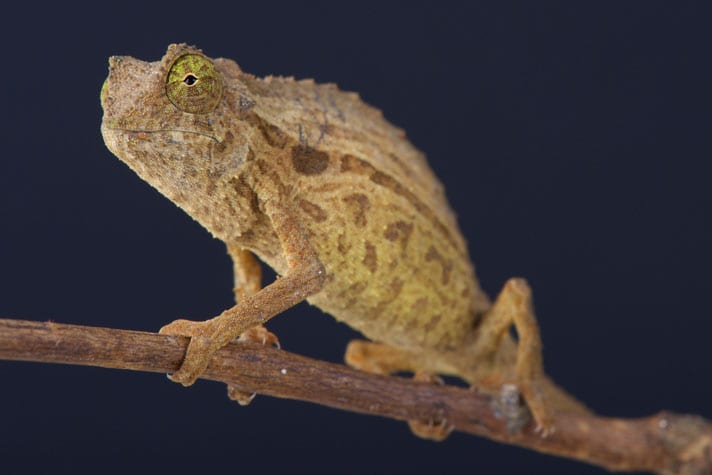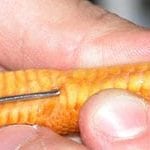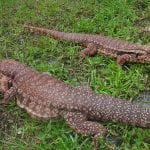Bearded leaf chameleon (Rieeppeleon brevicaudatus)
The bearded leaf chameleon also goes by the name stump-tailed chameleon, but most lizard owners and breeders prefer leaf chameleon because it closely resembles a leaf. They don’t look like smaller versions of other chameleons and are just small.
This lizard is found in Eastern Usambara and the Uluguru Mountains along the Eastern Arc of Tanzania. This is an area frequently compared to the Galapagos Islands when it comes to species diversity.
The bearded leaf lizard is one of the most commonly exported chameleon species, but there is little information about their natural habitat. Experts say that they prefer to remain near the ground in cool tropical forests.
Description
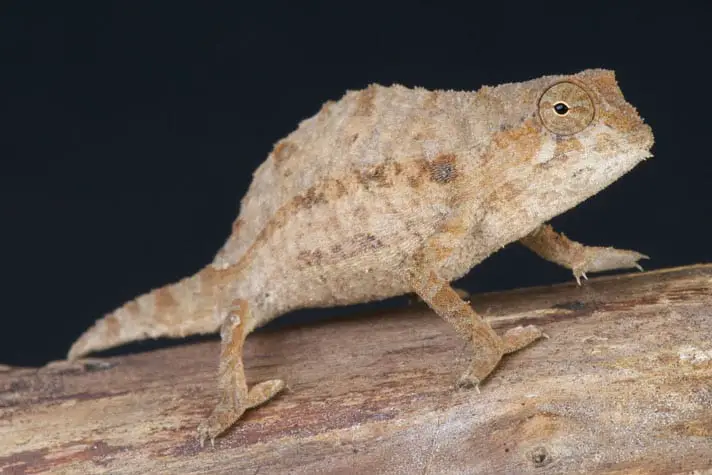
The bearded leaf chameleon is available in a variety of colors like green, brown, and tan. Some specimens have the unique capability to change colors. Males that are ready to breed come with bright horizontal stripes, while females are less colorful and expressive.
This lizard is quite similar to other larger chameleons, but they have a shorter tail. But despite this, they still use their tails to move around, as support for moving from branch to branch and also for taking the prey.
The term “bearded” term refers to the small goatee that can be seen on the chin. But other than these differences, the bearded leaf chameleon looks like other species of the dwarf of leaf chameleons.
Bearded leaf chameleons don’t exceed 3 inches in length. Males are more elongated with a fuller and longer tail. And other than the short tail, this lizard can be similar to its larger relatives with similar features like independently rotating eyes and opposable digits.
Health
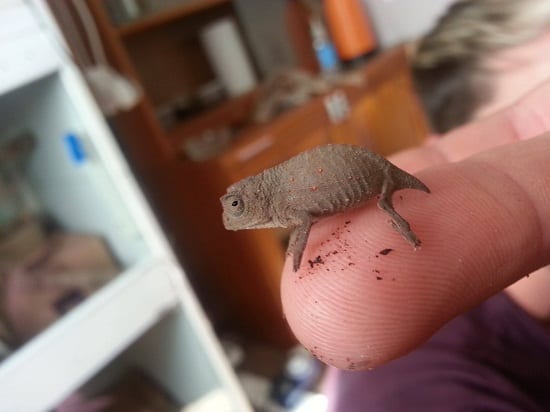
Bearded leaf chameleons live as long as their larger cousins. When cared for properly, a fully-grown and healthy adult can live up to four years. Just like other species, this chameleon does not do well with traveling because of dehydration, temperature extremes, and lack of food.
You can tell a healthy leaf chameleon from a sickly one by its appearance. Healthy specimens are full-bodied, have eyes that are constantly in motion, and are alert. Usually, it’s not enough to hydrate a leaf chameleon for recovery, but it is always important to start with a healthy lizard. When this lizard has recently traveled and has acclimated to a new tank or environment, it will usually remain in one spot for an entire day.
Caging and Accessories
A very important factor in caring for a bearded leaf chameleon is housing. This species is unlike other chameleons because these can be placed inside reptile terrariums. The bearded leaf chameleon is not afraid of its reflection as the glass helps reflect heat and conserve humidity inside the enclosure. Take note that maintaining the ideal humidity is important in a chameleon of this size.
For the cage accessories, place small sticks or branches inside the terrarium so the chameleon can sleep off the ground. If you want to add live plants, use UV lighting, and choose only low-light house plants because these are easier to maintain. Standard houseplants with smaller limbs and leaves will do well. But if you want to observe your leaf chameleon inside the tank, place only a few plants because this lizard can hide and mimic the color of leaves and stems.
The bearded leaf chameleon is good climbers. These can climb plants and screens, so place a lid on top of the terrarium. Don’t let your lizard escape because they are very hard to find. The lid will also protect them from other pets like a cat or a dog.
So where to keep the cage of your bearded leaf chameleon? The best place is the place where there are less noise and traffic. Stop children from hitting, tapping, or reaching into the terrarium. Never place it in the living room or kitchen where it is too busy. The ideal place is a spare room or a bedroom where it’s quiet and with very minimal traffic.
Heating and Lighting
Compared to other chameleon species, the bearded leaf chameleon does not need UV lamps. This lizard can stay in low areas of the forest where these don’t receive direct sunlight. Usually, these experience a 12/12 light/dark period all year round.
But if you have plants or you want to view your pet inside its terrarium, then you may add a UV cage lamp. Be careful that lighting is not too strong that it can dry the terrarium bedding. The bedding needs to be damp but not wet to provide the right humidity levels.
So if you want to install a UV lamp, then you may do so as long as you monitor temperature and humidity inside the tank. Keep the temperature and humidity levels constant by using a digital hygrometer and thermometer.
If the room where you’re keeping the lizard has a window, open it for indirect sunlight. This lizard also has good eyesight even at low light, so basically, this does not need any kind of artificial cage lighting.
The terrarium interior must be from 65 to 80 degrees Fahrenheit. Don’t exceed 90 degrees Fahrenheit because this is too hot for them. Regional variations in temperature preference exist. Some bearded leaf chameleons have adapted to their cooler surroundings as well as cooler environments indoors that too much heat already makes them uncomfortable. As a rule, this chameleon will do well in uniform temperatures but with a 10-degree fluctuation or even lesser.
If you’re looking for the best kind of lamp, a fluorescent lighting fixture is the best choice because this produces little heat. You don’t need to install under-tank heaters as well.
Substrate
Some species of chameleons are too demanding when it comes to the type of substrate to use, but the bearded leaf chameleon is an exception. It will tolerate any kind of substrate as long as these can hold more water without deteriorating and smelling weird.
There are several substrates that you can use, but the best is still a natural kind of substrates, such as organic humus, leaf litter, or peat moss. Don’t use coconut fiber unless these are aged fibers. This is coconut fiber that has been used to allow debris and fungi to mold with the fibers. This chameleon can ingest raw coconut fibers, and these small fibers can cause impactions inside their digestive tracts.
Food
The bearded leaf chameleon is not a picky eater, and in fact, it will eat any kind of food as long as it is small enough to eat. This lizard has a very powerful tongue that can reach food in distances that are twice their lengths. Take note that the ideal prey size is the width of the lizard’s head between their eyes.
They love pinhead crickets, fruit flies, and other smaller insects. This is a lean lizard, with very little fat and thus should be fed regularly. But when provided with ample food supply, a leaf chameleon may not eat except for newly introduced food items.
Because this chameleon has very low energy requirements, they don’t need to eat very frequently like other chameleon species. An average-sized bearded leaf chameleon can eat only a dozen pinhead crickets a week.
Other food items that a chameleon will love are wax worms and small hatchling locusts. Make sure, though, that the worms are very small and are easy to consume.
Some chameleon pet owners practice gut-loading, which is placing supplements or other types of food inside the lizard’s insect foods to provide additional nutrients. Some gut load insects with carrots, potatoes, broccoli, and other nutritious food. Dusting food with calcium is also a good way to provide the mineral. Lizards need calcium for stronger bones and during egg-laying. Calcium dusting should be done at least once a week.
If you have more than one bearded leaf chameleon inside an enclosure, consider placing a feeding dish for each of the lizards.
Water and Humidity
The bearded leaf chameleon is easy to care for, but you must maintain the right humidity inside the enclosure. Although this lizard is not as sensitive as its other cousins like the R. spinosus, it is still crucial that you keep its cage in the right humidity for good health.
In places where humidity is low, misting the interior of the terrarium should be done at least twice a day. In places where it’s dry most of the year, misting should be done all year round. And in places where humidity levels are high, misting can be done once a day.
Also, consider that humidity levels are too high enough for the enclosure to develop molds. So monitor the enclosure frequently for molds and clean it up ASAP.
Use a small misting bottle with plain water. If you mist daily, you don’t need to place a water dish inside the terrarium. The chameleon will simply drink the moisture that accumulates on leaves, on the tank walls, and other surfaces inside the enclosure.
Local water or tap water may be used as long as the water is not too hard. Hard water can create mineral scales on the glass and on the leaves but does not affect the chameleon. So if you don’t want your view obstructed, use purified or bottled water instead.
Preserving the right humidity inside the enclosure is important for shedding. All lizards shed, and if the humidity levels are too low, drying of the skin can happen, and this can result in an incomplete shedding. In an incomplete shedding, the chameleon may find it hard to shed its old skin, and thus, large patches of dry and old skin may remain, and this can cause pain when the skin is wrapped around a limb or tail.
Therefore, humidity levels should be kept high for good health and proper shedding but not to the point that molds can grow. Invest in a digital hygrometer and thermometer for proper terrarium monitoring.
Handling
As much as possible, avoid handling a bearded leaf chameleon. Although this lizard is friendly and won’t mind being handled, dropping it, even in small heights, can injure it. If accidentally dropped or mishandled, it can be easily stepped on as well.
This chameleon is not frightened by humans and won’t mind being observed, too, so it’s best just to admire its cuteness and delicateness from a distance. The bearded leaf chameleon is a sedentary chameleon and won’t move unless they are being fed.
This has been known to stay in the same spot for a day, some moving less than six inches in a day. When observed inside their enclosures, male bearded leaf chameleons are likely to stay perched on a tall branch, leaf, or stick. Males prefer to look around and observe. Females tend to stay lower or on the ground where they can hide and rest.
Male bearded leaf chameleons also love to flaunt their dazzling colors and their stripes even when it’s past the breeding season. Females prefer to remain dull-looking and less obvious inside the tank.
This chameleon is also known to emit a sound similar to a buzz. You will hear this audible sound when you handle this lizard. It is still unknown as to why it gives off this buzzing sound, but it is thought that it can keep off predators and even prey off them at night.
Breeding and other behaviors
You’ll find mixed tips and techniques when it comes to breeding bearded leaf chameleons online. Some say that males can be placed with other males in an enclosure while some recommend keeping each male in one terrarium for safety.
Some breeders have experienced troublesome conditions inside shared male chameleon enclosures. One male will likely dominate the enclosure, and other males submit by hiding. The submissive specimens will stop hunting or foraging, will hide in one spot, and will become very stressed. Some males can even become so stressed that they die.
Female bearded leaf chameleons may also suffer the same fate as they are supposed to remain in groups inside a terrarium for breeding. A dominant female will likely rule the enclosure, and non-dominant females will hide, refuse to eat, and eventually die of stress. You can place additional cage furniture or accessories to avoid stressing the female, but on the safe side, it’s better to house them in a 1:1 ratio for breeding success.
Before we discuss breeding, it’s appropriate to understand what stresses this chameleon so you’ll be able to provide the best care. First, you need to distinguish stressed behavior from their routine. Stress behavior may be confusing for an inexperienced breeder.
Usually, bearded leaf chameleons will sleep and rest in one particular spot every day. This may even remain in one spot to rest and make it their favorite spot. When stressed, the chameleon will hide in a place that it has not used before or look for other resting places that it is not used to before. It may remain in this area, cowering and refusing to go out even to eat.
Non-stressed individuals will wander inside the cage and will pay little to no attention to their cage mates, but a stressed lizard will just remain still and won’t move for many hours. You will instantly notice the dominant chameleon inside the cage because this is the one that moves around freely.
You won’t find cage mates interacting when they are stressed. So at the first sign of stress or you suspect that an individual is stressed, remove it from the cage and transfer it to its cage. It may still recover when given enough time to do so.
During the breeding season, the male will display its brightest colors and stripes. You’ll notice that the male is very interested in a female if he spends a lot of time near her but not very near. When the male approaches the female, and she is not interested in mating, she will display a rocking behavior. However, the male will ignore her and will tackle her in a swift movement.
The female will roll to her back or move to oppose the male’s advances. Eventually, the male will understand and move away. If she succumbs to his moves, the female will lay still, and the male quickly mounts her, and the mating act is over. Female bearded leaf dragons are capable of retaining sperm inside her body. Thus, she can become pregnant whenever she wants to even after the breeding season is over.
You’ll know when the female is pregnant as she will increase in size. The gestation period is a month or so, and she will lay one to five eggs. Female leaf chameleons don’t spend too much time constructing her nest, unlike other animals, and she does not take time to look for a good spot. She merely digs a hole anywhere and then deposits her eggs. She may even just lay her eggs on the ground.
Eggs are as small as a grain of rice. The incubation stage of a bearded leaf chameleon is the shortest at only 60 to 75 days. Eggs that are laid higher from the ground have a better chance to survive than eggs laid on the ground because predators can prey on the eggs.
Breeders usually get the eggs and incubate them in perlite, vermiculite, or other media in 75% humidity. The young chameleons have very large heads and can feed on prey almost immediately after they hatch.
The bearded leaf chameleons have almost the same health issues as their larger family members. This includes skin, eye and mouth problems, infections, and parasites. Usually, a breeder will quarantine new chameleons before introducing it to other individuals or before allowing it to breed to ensure good health. The quarantine period may last from a month to several months just to be sure that the chameleon has no illness that it can spread to others.
Have a qualified exotic vet check your pet for any problems. Schedule at least yearly visits, and don’t forget to take it to the vet for any medical problem. Most bearded leaf chameleons grow up happy, healthy, and contented as pets and can surpass the lifespan of wild specimens as well.
The cost
You’ll find bearded leaf chameleons from a local exotic pet store or an online pet store. This chameleon may cost around $50 to $100 depending on its size, color, and gender. The cost of maintenance is low, and if you have used supplies and cages lying around, then you may use them; no need to spend at all.
Taking your new pet home
If you just recently purchased a bearded leaf chameleon, then congratulations! You have an interesting pet and a cool chameleon to share your living space with. But remember the following tips as you take your new pet home from the pet shop:
The chameleon’s terrarium should be ready and waiting for him when he gets home. The temperature, humidity, and the substrate should be ready.
Take your pet home in a small container with a lid. A plastic container will do. Place a small amount of substrate in the container. This will help your new pet get used to its new home. Mist the container if you are traveling for a longer distance. Take your mister with you if you are traveling for a day. No need to bring food since it won’t eat anyway.
Transporting the chameleon often stresses it, and thus, you must move it cautiously. Use some towels to delicately hold the container in your car or vehicle.
Once you’re finally home, open the container slightly and then eventually place the opened container inside the tank after an hour. Don’t just dump the chameleon inside the tank! Just let it move out of its container naturally. It will soon realize that it is in a new safe, and secure place.
Your new pet won’t eat for a few days, so don’t worry. It will initially look for a place to sit still and remain there. But once it has adjusted, it will come out of hiding and look for food. This is the best time to offer food.

